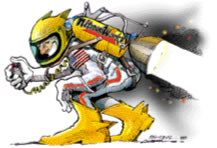Maybe a little off the normal path here, but I thought some might enjoy a glimps of my involvement with props.
Anyone remember their childhood days of starting, flying and crashing Cox .049 airplanes? The first smells of burnt nitro, alky and castor oil?
I scratch build wooden 18" R/C powerboats that use these engines. Some are flat bottom, some vee types, others hydros and just finished up another byrillium copper prop for one of them.
The props I work are 1" in diameter and use small, silicon carbide polishing sticks and oil which are commonly used to polish mold cavities in plastic injection molds.
They come in all grit sizes just like sandpaper does, and I usually start at 120 grit and go up to about 600 grit before the polishing creams can take over.
All these type props arrive as rough castings with only a finished bore size, and you are the one that has to become the jeweler to make them work.
Each one can take up to a couple of evenings of polishing, sharpening and balancing before they can be called complete. Time well spent when they top off the looks of your boat or seeing them doing good on the pond.
Ultimate care is required to break through the hard scale and down past the pitting to not mis-shape the cupping or profiles. With them being so tiny and spinning so fast, every small detail means the world with how well they perform and so easy to scrap if you're not watching. There's just simply not much there to correct if there's a mistake.
After the cup faces are sucessfully smoothed, they can be further shaped with the stones to change the outline, or introduce more kick-out lip, or cupping. Next step past this would be to remove the hub parting line and comb the profile of the blades. Impressions in hard clay help me match outlines from blade to blade.
The prop is then turned over, and the front of the blades are then thinned out as much as possible, and the balancing process begins along with it using a static balancer stand and an arbor. Final balancing is performed with the final sharpening process of the leading edges.
They are sharpened as much as you dare before the bronze wants to roll a burr. If this happens, you have just ruined the prop. The original outline of the blade can't really be brought back after this happening.
With them being the smallest metal performance props available on the market, the Cox engine can spin them to 26,000 RPM and can push one of these little 18" hulls close to 25 mph which is well past the scale speed and a joy to watch.
All the same principles apply to these as full scale props, they just take up a lot less room on the bench. They have been lots of fun for me to learn and test.
Below is a raw prop face. Note the surface scale which can be tough and the deep pitting that has to be worked through...
The following is after the first cleanup with a coarse 180 grit stone. The only target at this point is to get past the scale and pitting while maintaining the stock shape and preserving the edges.
After getting into the marrow of the prop, polishing is switched to progressivly smoother stones to help pick up reflections to check shapes, and possibly having to switching back to a lower grit to help correct it.
Below is a picture that shows a skated surface stepped down to a complete finish.
A nylon plastic version is offered in 1", but for me...it simply doesn't thrill. Boat props are suppose to be able to show your smile, plus you really can't play with tuning them very much.
Below I shared a couple of examples of the boats. The first is modeled after the classic Hallet SK boat, and the other Bill Muncey's famous Atlas Van Lines unlimited hydro.
I'm still learning all the basic characteristics that help make up a prop so join in if you have any thoughts or ideas. I am still guessing what amount of relief angle to put on the trailing edges and such, so if you see anything good or bad, share the knowlege! I try and study as many pictures as I can, and been reading all I come across and it's never enough!
Hope you enjoyed.


 Thanks:
Thanks:  Likes:
Likes: 










 Reply With Quote
Reply With Quote
Bookmarks